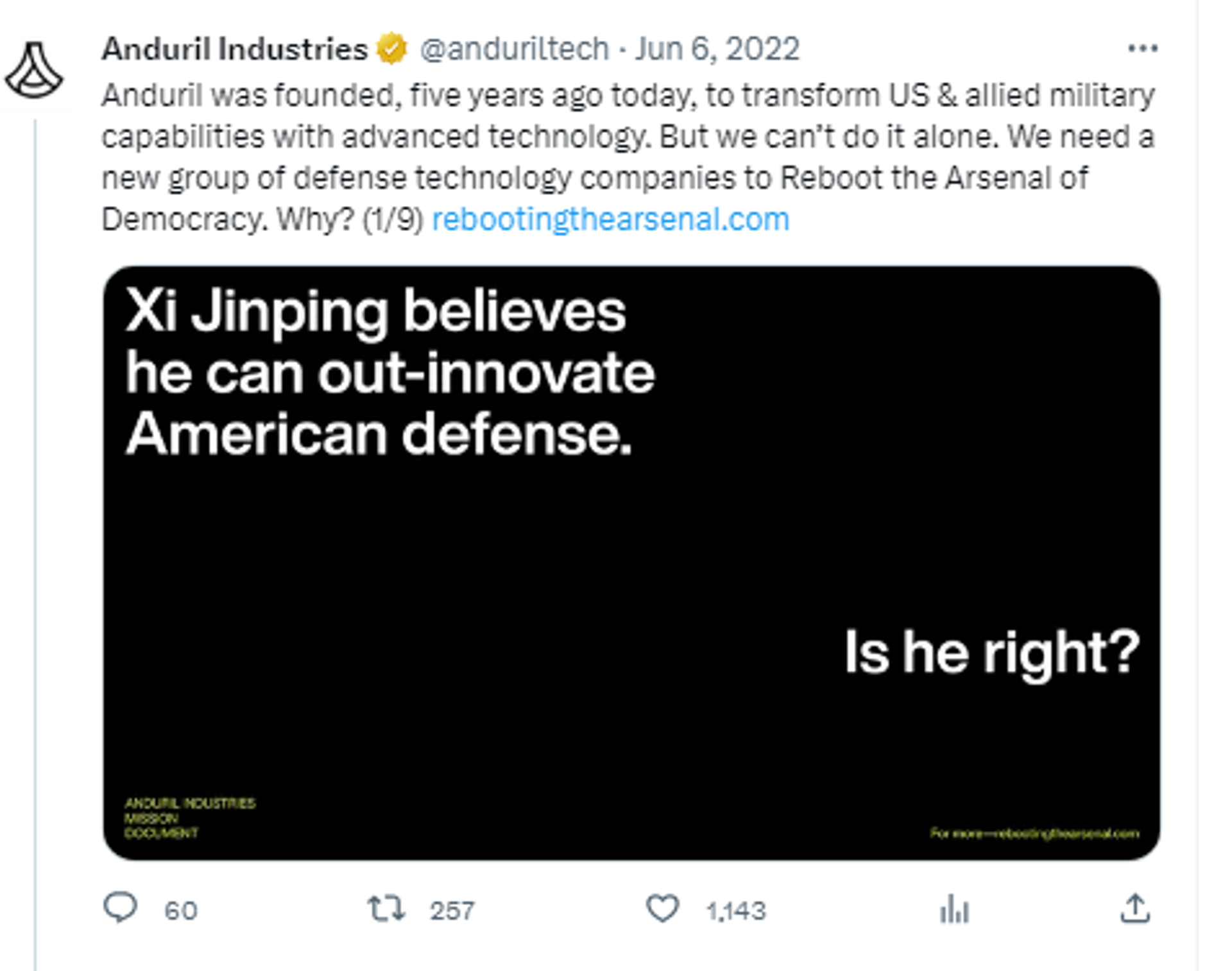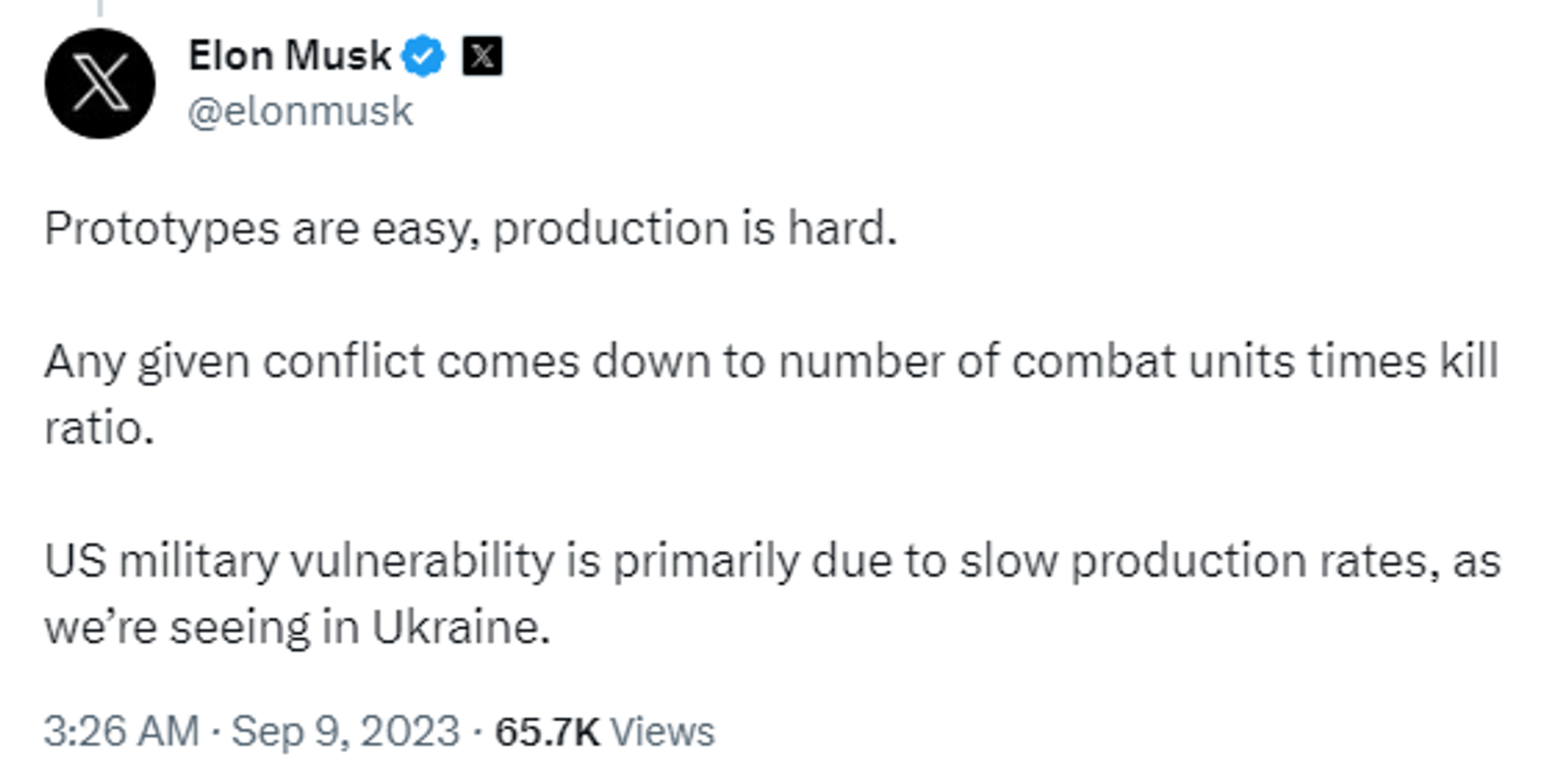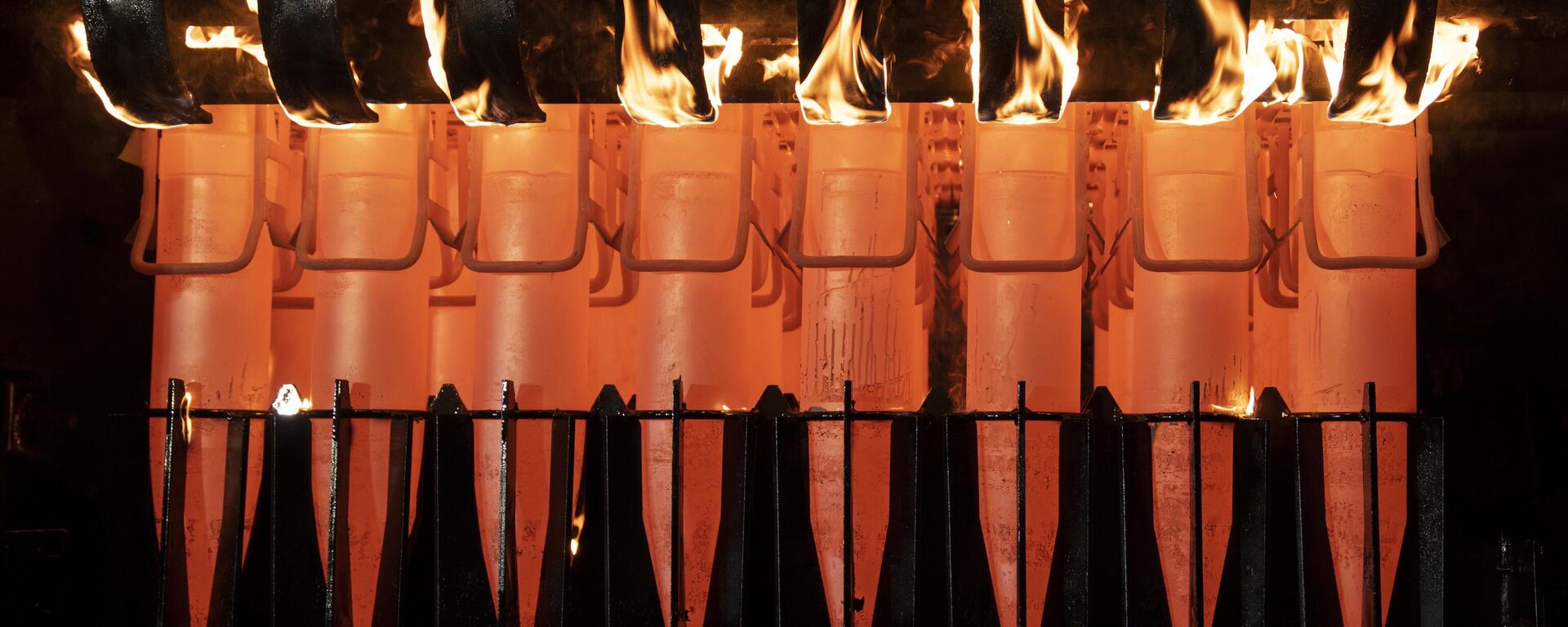https://sputnikglobe.com/20230909/musk-us-military-vulnerability-due-to-slow-production-rates-as-seen-in-ukraine-1113224062.html
Musk: US 'Military Vulnerability' Due to 'Slow Production Rates, as Seen in Ukraine'
Musk: US 'Military Vulnerability' Due to 'Slow Production Rates, as Seen in Ukraine'
Sputnik International
US military vulnerability primarily “stems from the slow pace of production, as we are seeing in Ukraine,” American entrepreneur and billionaire Elon Musk has pointed out.
2023-09-09T09:03+0000
2023-09-09T09:03+0000
2023-09-09T09:03+0000
americas
us
elon musk
spacex
starlink
ukraine
military production
https://cdn1.img.sputnikglobe.com/img/07e7/07/11/1111938569_0:160:3072:1888_1920x0_80_0_0_f74dc4b7443ae15785e241b9cd378496.jpg
US military vulnerability primarily “stems from the slow pace of production,” American entrepreneur and billionaire Elon Musk has pointed out.The tech guru took to his social media platform X (formerly Twitter), to comment on last year’s post by the company Anduril Industries. On its five-year anniversary, the military technology company had argued the need for a joint effort if it was expected to “transform US and allied military capabilities with advanced technology.” We need “a new group of defense technology companies to Reboot the Arsenal of Democracy,” the firm had stated.In response, Musk voiced the opinion that “slow production rates, as we’re seeing in Ukraine,” was the chief US military's weak spot.The entrepreneur also emphasized that making new prototypes is easy, but putting them into production is hard.This comes as the third month of Ukraine's botched counteroffensive has wrapped up, with the Kiev regime unable to boast any significant military gains, while US stockpiles of munitions are getting “dangerously low".Meanwhile, the US unveiled the latest military package for the Kiev regime, worth $250 million, late in August, including AIM-9M missiles for air defense, munitions for High Mobility Artillery Rocket Systems (HIMARS), 155mm and 105mm artillery ammunition, mine-clearing equipment, Javelin and other anti-armor systems and rockets, three million rounds of small arms ammunition, as well as other items. However, by continuing to funnel military aid to Kiev the US is reportedly fast-depleting its own military caches of various weapons. Thus, depletion of US stockpiles of 155mm artillery shells (for howitzer use) was recently cited in a US report, with the additional revelation that Washington was sending Kiev 155mm and 105mm shells for the simple reason that it no longer had adequate stockpiles of 155mm shells.As for Elon Musk, the SpaceX CEO recently clarified in a statement that he had declined to activate the company's Starlink satellite internet service network over Crimea in order to enable a Ukrainian strike on the Russian naval fleet back in 2022."The Starlink regions in question were not activated. SpaceX did not deactivate anything," Musk said on Thursday, via X, adding that, "If I had agreed to their request, then SpaceX would be explicitly complicit in a major act of war and conflict escalation."The owner of the socia media platform's comments were in response to excerpts cited in US media from the upcoming Musk biography authored by writer Walter Isaacson. The book reportedly outlines how Musk sought to avoid a "mini-Pearl Harbor" breaking out after conversing with senior Russian and American officials, including national security adviser Jake Sullivan."Starlink was not meant to be involved in wars," Musk is said to have told Isaacson.
https://sputnikglobe.com/20230710/us-europeans-depleted-their-weapons-stockpiles-fighting-russia-in-ukraine-1111797051.html
https://sputnikglobe.com/20230830/biden-flogs-a-dead-horse-by-sending-250mln-in-arms-to-ukraine--1112994610.html
https://sputnikglobe.com/20230908/musk-clarifies-he-declined-starlink-activation-request-to-enable-2022-ukraine-strike-near-crimea-1113191738.html
americas
ukraine
Sputnik International
feedback@sputniknews.com
+74956456601
MIA „Rossiya Segodnya“
2023
News
en_EN
Sputnik International
feedback@sputniknews.com
+74956456601
MIA „Rossiya Segodnya“
Sputnik International
feedback@sputniknews.com
+74956456601
MIA „Rossiya Segodnya“
ukraine counteroffensive, botched ukraine counteroffensive, elon musk, starlink satellite internet service network
ukraine counteroffensive, botched ukraine counteroffensive, elon musk, starlink satellite internet service network
Musk: US 'Military Vulnerability' Due to 'Slow Production Rates, as Seen in Ukraine'
Amid Kiev’s faltering counteroffensive, Russian forces have been successfully destroying NATO-supplied weaponry, leaving many of Ukraine’s Western patrons facing a situation where their own stockpiles are being hollowed out. Accordingly, ramping up production of munitions is becoming a challenging issue – something that Elon Musk has weighed in on.
US military vulnerability primarily “
stems from the slow pace of production,” American entrepreneur and
billionaire Elon Musk has pointed out.
The tech guru took to his social media platform X (formerly Twitter), to comment on last year’s post by the company Anduril Industries. On its five-year anniversary, the military technology company had argued the need for a joint effort if it was expected to “transform US and allied military capabilities with advanced technology.” We need “a new group of defense technology companies to Reboot the Arsenal of Democracy,” the firm had stated.
In response, Musk voiced the opinion that “slow production rates, as we’re seeing in Ukraine,” was the chief US military's weak spot.
The entrepreneur also emphasized that making new prototypes is easy, but putting them into production is hard.
This comes as the third month of Ukraine's
botched counteroffensive has wrapped up, with the Kiev regime unable to boast any significant military gains, while US stockpiles of munitions are getting “
dangerously low".
As of August 30, 2023, Ukraine has reportedly lost 466 airplanes, 247 helicopters, 6,234 unmanned aerial vehicles, 433 air defense missile systems, 11,570 tanks and other armored fighting vehicles, 1,146 fighting vehicles equipped with MLRS, 6,128 field artillery cannons and mortars, as well as 12,528 special military motor vehicles since the beginning of the special military operation.
Meanwhile, the US unveiled the latest military package for the Kiev regime, worth $250 million, late in August, including AIM-9M missiles for air defense, munitions for High Mobility Artillery Rocket Systems (HIMARS), 155mm and 105mm artillery ammunition, mine-clearing equipment, Javelin and other anti-armor systems and rockets, three million rounds of small arms ammunition, as well as other items. However, by continuing
to funnel military aid to Kiev the US is reportedly fast-depleting its own military caches of various weapons. Thus,
depletion of US stockpiles of
155mm artillery shells (for howitzer use) was recently cited in a US report, with the additional revelation that Washington was sending Kiev 155mm and 105mm shells for the simple reason that it no longer had adequate stockpiles of 155mm shells.
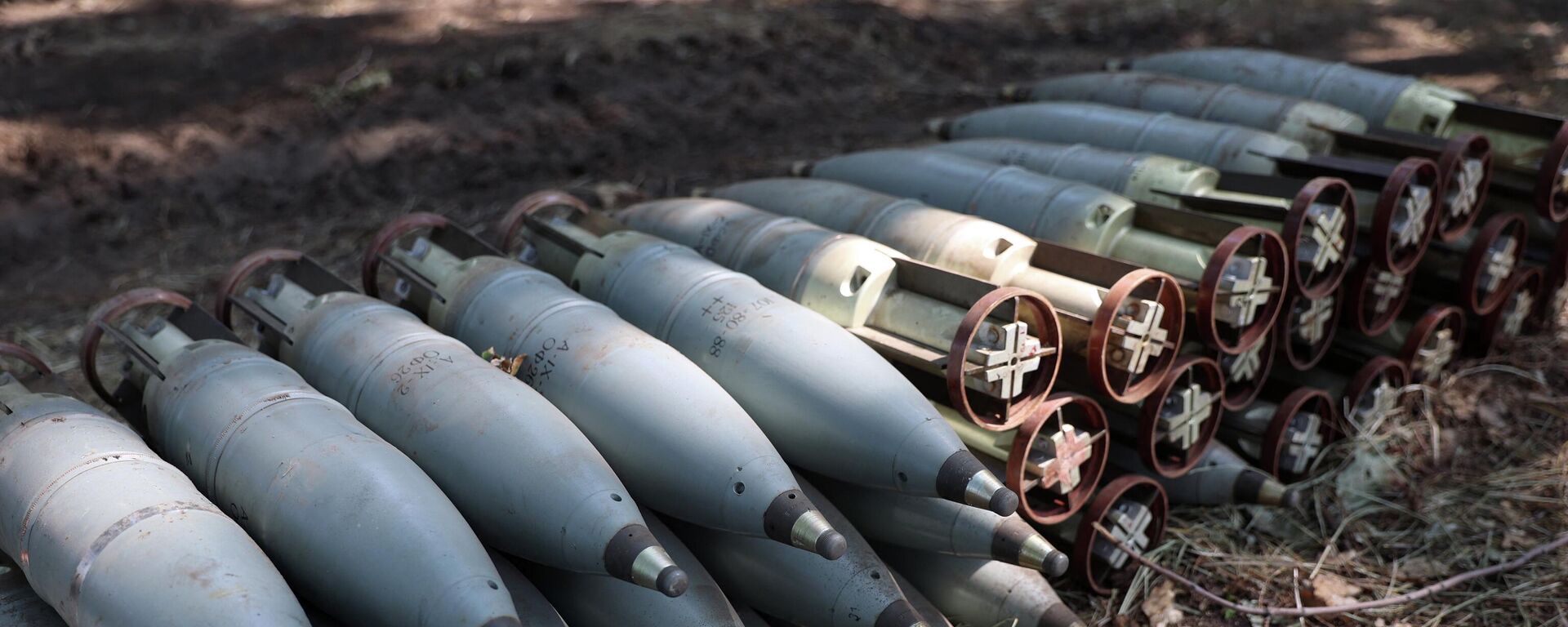
30 August 2023, 16:40 GMT
As for Elon Musk, the SpaceX CEO recently clarified in a statement that he had declined to activate the company's Starlink satellite internet service network over Crimea in order to enable a Ukrainian strike on the Russian naval fleet back in 2022.
"The Starlink regions in question were not activated. SpaceX did not deactivate anything," Musk said on Thursday, via X, adding that, "If I had agreed to their request, then SpaceX would be explicitly complicit in a major act of war and conflict escalation."
The owner of the socia media platform's comments were in
response to excerpts cited in US media from the upcoming Musk biography authored by writer Walter Isaacson. The book reportedly outlines how Musk sought to avoid a "mini-Pearl Harbor" breaking out after conversing with senior Russian and American officials, including national security adviser Jake Sullivan.
"
Starlink was not meant to be involved in wars," Musk is said to have told Isaacson.
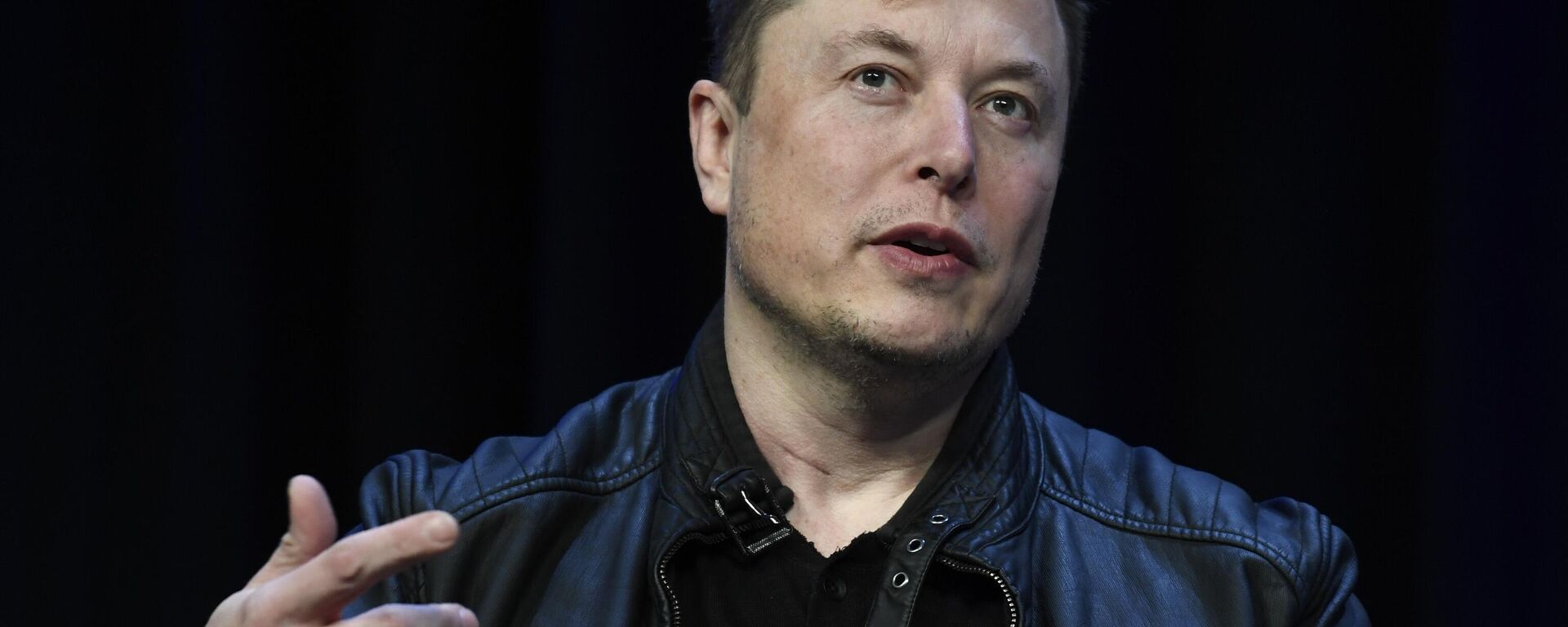
8 September 2023, 00:17 GMT

